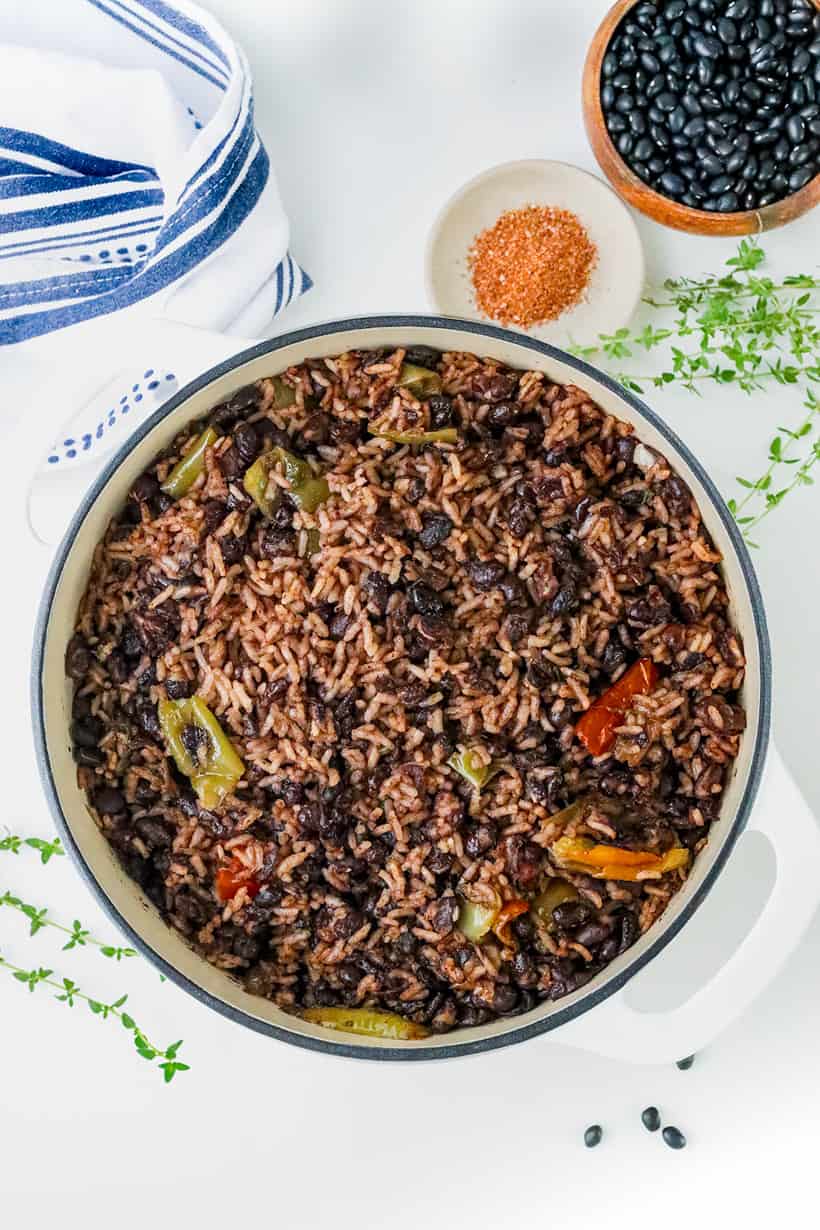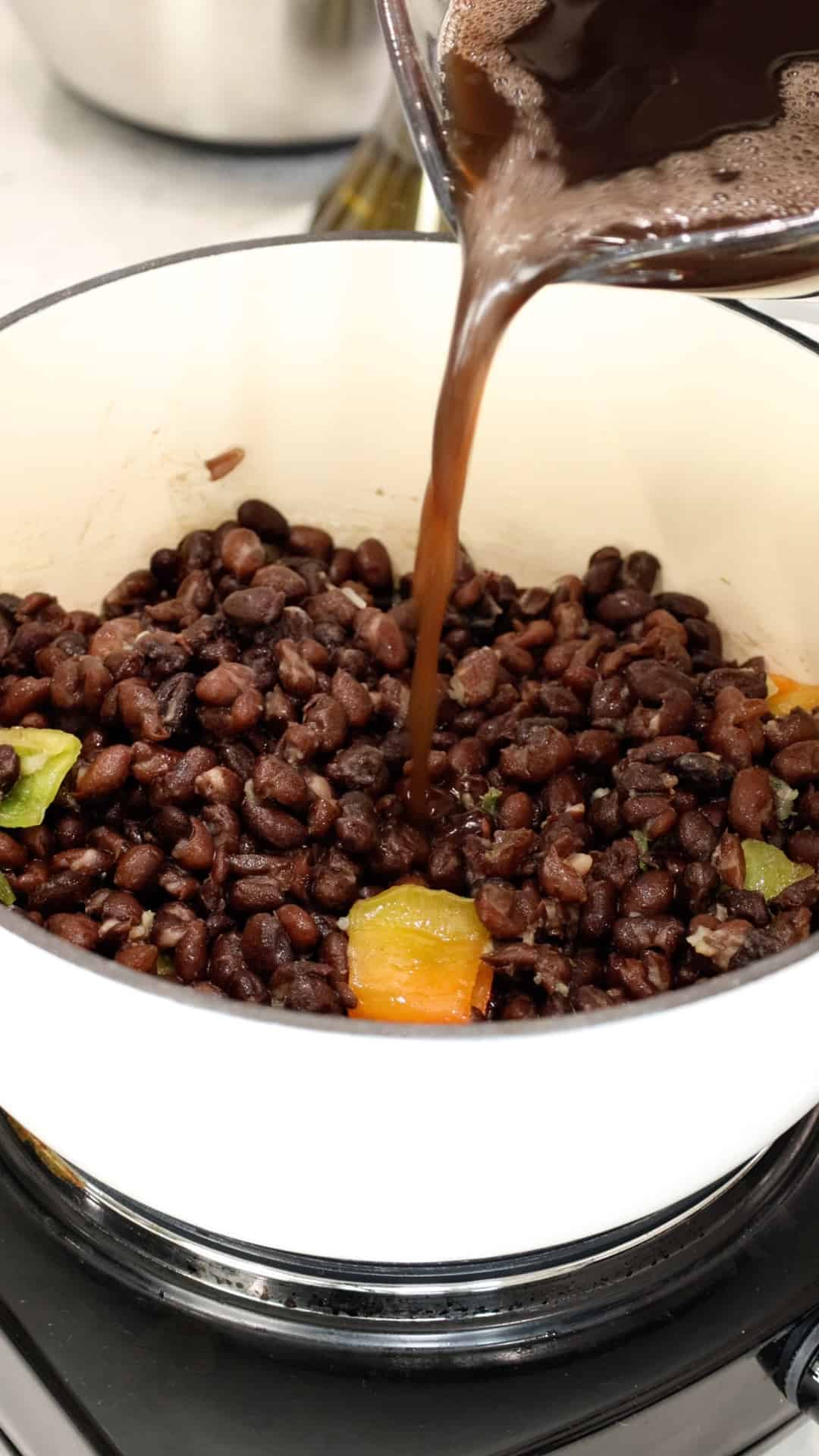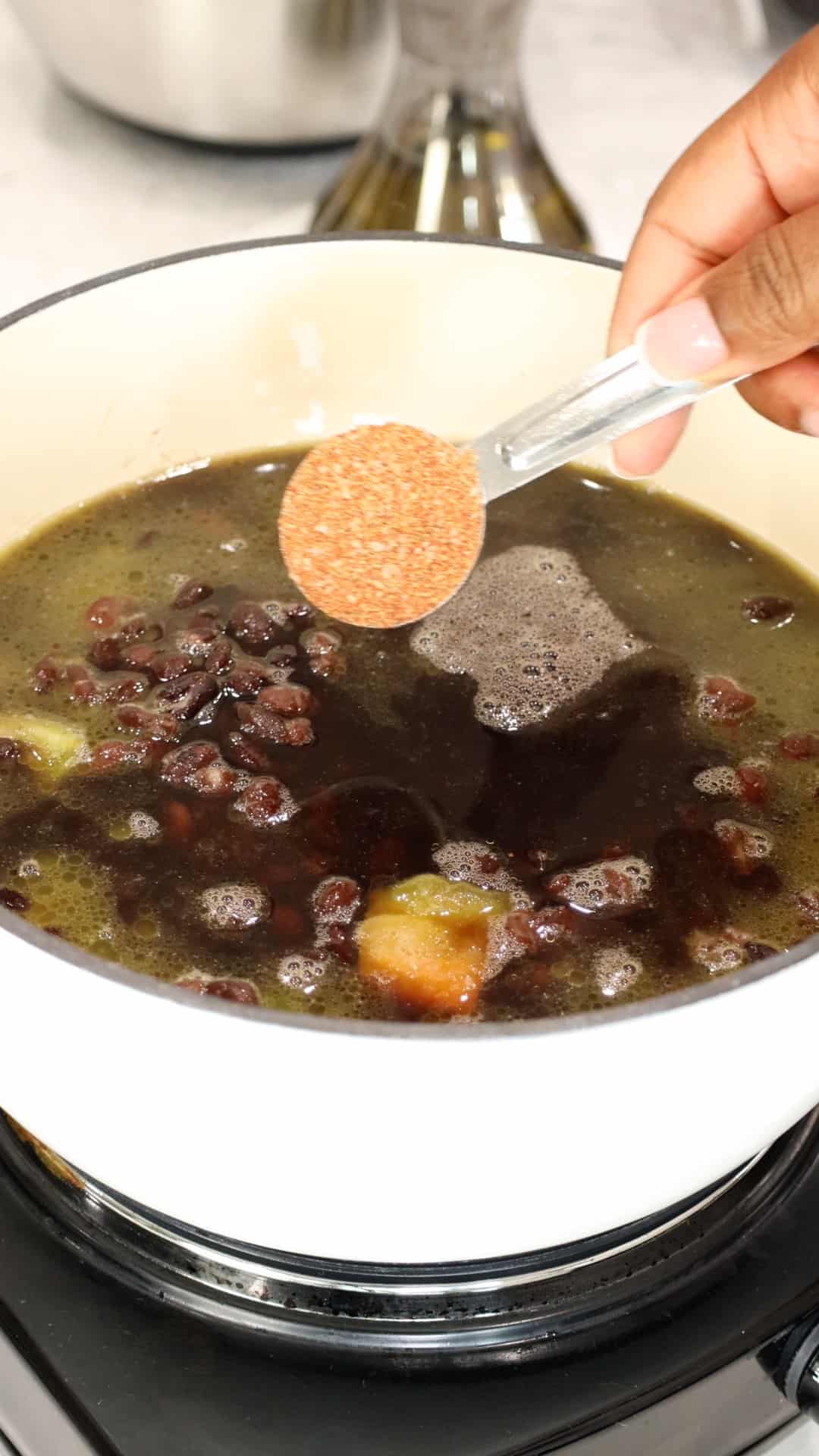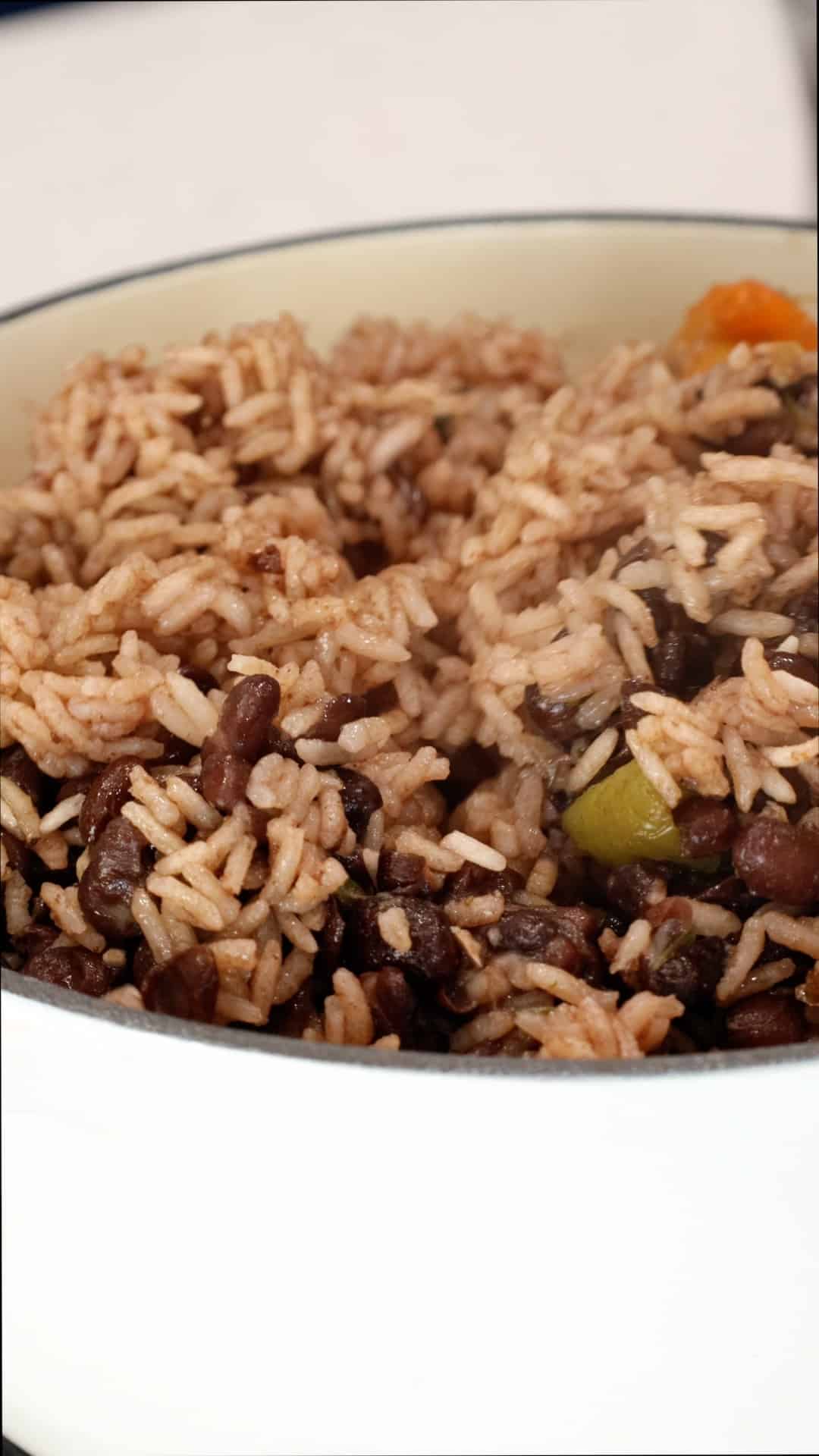Prepare this bold and flavorful Haitian black beans and rice (Diri Kole Ak Pwa Nwa) recipe that makes for a tasty and flavorful side dish. Fluffy rice simmered with fiber-rich legumes.

Throughout Haiti you can find a pot of Haitian black beans and rice (Diri Kole Ak Pwa Nwa) in someone’s kitchen. This classic Haitian rice dish filled famished bellies for centuries. It’s one of the many delicious rice recipes to make on repeat.
Prepared with a special seasoning base to provide a bold flavor profile, this recipe is one of the classiest one out there.
Haitian Black Beans And Rice (Diri Kole Ak Pwa Nwa)
If you are someone who likes legumes and beans, you will fall in love with this rice dish. As the name suggests, it’s made with a combination black beans and rice cooked together in one pot.
Presoaked or not, one the beans are cooked, the dish achieves a beautiful grayish appearance due to the dark colored liquid from cooking the beans.
One plate of diri kole ak pwa nwa (Haitian Black Beans and Rice) has a lot of diversity, be it in flavors or serving. It is a fusion of flavors, including French, Taino, and African culinary experiences, which has a rich blend flavors.
The beans are cooked until they achieve a mildly tender texture – but not to achieve a creamy base.
Haitian Black Beans and Rice are enhanced with a variety of spices and herbs, such as parsley, thyme, cloves, scallions or onions, and garlic.
History of Rice
Rice has taken care of additional individuals over a more extended timeframe than some other harvest.
Its set of experiences dates as far back as 2500 B.C. also, has been a fundamental piece of many culture’s weight control plans all over the planet. In fact, archaeological evidence indicates that China’s Yangtze River valley is where rice was thought to have been first domesticated.
The crop thereafter expanded via trade routes and trading hubs around the world. Then, rice was brought to Sri Lanka and India from China. Later, it traveled across Greece and other Mediterranean regions before arriving in the New World from Europe.
This ancient grain was able to adapt to several climatic conditions, which allowed it to become a global crop and a crucial source of carbohydrates even now.
History of Beans
Beans have a lengthy history, much like rice. One of the earliest known meals are the seeded pods of different legumes. For instance, fava beans that were cultivated and carbon-dated decades ago were discovered in what is now northern Israel.

Even before grains were extensively farmed, fava beans were a significant component of the Mediterranean diet.
Ancient Greek and Egyptian tombs include evidence of chickpeas and lentils, which were also popular crops in the ancient world.
Beans were progressively introduced to India, northern Africa, Spain, and the rest of Europe through commerce and travel, much like rice.
Bean consumption by humans dates back centuries; therefore the Americas were also a major region for bean cultivation.
Recipe Variations
When it comes to flavor, chicken or pork broth, and even bouillon may be added to enhance the flavor and richness of the dish.
As far as the spices are concerned, we recommend using Scotch Bonnet pepper or our Jacmel spice blend or a true and authentic bold flavor.
The moderately sweet flavor of the Scotch Bonnet pepper has undertones of cherry and apple; you’ll adore the variety in flavor. Finish the meal by adding some fresh basil, parsley, or thyme.
Diri Kole Ak Pwa Nwa Ingredients
- Vegetables. Onions and Bell Pepper. You can also add Scotch Bonnet Pepper (see notes below), and Garlic Cloves.
- Seasonings. Salt, Pepper, Jacmel Seasoning.
- Herbs. Fresh Thyme and Fresh Parsley.
- Beans. I use dried black beans for this recipe. If you want to use canned beans, be mindful that the color will not be as rich.
- Liquids. In this recipe I used water, as this is what’s commonly used in Haiti. However, you may alter it by using chicken broth or stock. For a hint of acidity, you can add apple cider vinegar.
- Rice. For this recipe I used Jasmin rice. You can use any white rice. My favorites to use in this recipe is Jasmin or Basmati rice. White rice is ideal.
- Extras. Olive oil for cooking, chopped parsley for serving.

Diri Ak Pwa Nwa Cooking Method
Wash the beans thoroughly and drain the liquid. Transfer the beans to the Instant Pot with 8 cups of water (see notes)Press Beans/Chili and adjust the timer to 25 minutes.
The Instant Pot will rise to temperature and will begin to cook the beans. Once done, carefully quick release. Using a large bowl, strain the beans and reserve the liquid. Do not throw the liquid away.




Cook the Haitian Rice and Beans: Over the stove on medium-high heat and using a medium-sized saucepan or pot, add 4 Tbsp. Olive Oil.
Then add the onions, peppers, and garlic. Cook for about 1 minute, stirring occasionally to avoid burning.
Next, add the strained beans and stir lightly twice. Cook for about 1-2 minutes, then add the washed rice.
Add 1 Tbsp. Jacmel seasoning and salt (to taste). Add the liquid from the cooked beans, and add the herbs.




Stir twice from the bottom up. Reduce the heat to medium-low. Half way cover the pot/pan with a lid and cook the rice until the liquid has evaporated.
Once the liquid is gone, reduce the heat to low and cover completely. When the rice is cooked, fluff and serve immediately.
Pairing Suggestions
This rice is a hearty and flavorful recipe which can be paired with different sides. In the section below, we are sharing a few sides that you can savor, such as;
- Pikliz – This is a spicy pickled vegetable side that’s made with cabbage, carrots, onions, and Scotch bonnet peppers. It adds a tangy and spicy kick to the meal, which helps balance the flavors.
- Fried Plantain – Haitian fried plantains are fried twice and compliment this rice perfectly and gives it a nice contrast.
- Haitian Salad – This is a simple salad with fresh lettuce, tomatoes, and sometimes cucumber that’s dressed with a vinaigrette. It helps provide a refreshing and healthy side.
- Haitian Beef Stew – This stew is prepared with bone-in beef cut or short ribs, and is simmered in a delicious tomato rich sauce.
- Poulet En Sauce – Nothing better goes well with Haitian black beans and rice. The flavor of the poulet en sauce and the rice and beans compliment each other well; making this dish a complete meal.

Pro Tips & Notes
- The Beans. Although you can use canned beans in this recipe, I highly recommend you use dry black beans. No need to let the beans soak first, as this is not traditionally soaked prior to cooking. However, soaking the beans reduces the gas that’s produced when the food is being digested.
- The Rice. Similar to Mexican rice, Haitian red beans and rice are also coked together, in one pot. I like to use either Jasmin rice or Basmati Rice, which are both long grain rice. To avoid having a super sticky rice, avoid using short grain rice as it may mush. This type of rice is commonly used for sushi or if you are purposely making sticky rice.
Storing Options
Can’t imagine you will have leftover, however, be sure to use the correct storage method to ensure that this Haitian Black Beans and Rice remain fresh and taste amazing for a long time.
We recommend that you cool the rice down to temperature before transferring it in an airtight container. An airtight container will ensure that there’s no condensation (it’s important to increase the shelf life).
More Rice Recipes to Enjoy
After trying this diri ak pwa rouj recipe, we recommend you try this stovetop Haitian red beans and rice recipe, this Instant Pot Haitian red and beans and rice recipe, this Instant Pot Pigeon Peas and Rice recipe, this Haitian White Rice Recipe, and this Okra rice recipe.
It warms our hearts to see the recipes you make from this site. We’d especially would love to know if you tried our recipe, tag us on Instagram or Facebook so I can see your beautiful dish.
Also, we would appreciate it if could give it a star rating below!

Haitian Black Beans And Rice Recipe
Equipment
- Saucepan or medium pot
Ingredients
Cook the beans
- 1 ½ Cups Dry Black Beans
- 8 Cups Water; Reserve 3 Cups of the beans liquid after cooking
Prepare the rice
- 4 Tbsp. Olive Oil
- ¼ Cup Chopped Onions
- ½ Bell Pepper; Any color will work
- 2 ½ tsp. Kosher Salt or to taste
- ½ tsp. Ground Black Pepper
- 6 Cloves Garlic; Minced or smashed with mortar and pestle
- 3 Cups Liquid From Cooked Beans
- 2 ½ Cups Jasmine Rice; Or Basmati Rice
- Bunch of Fresh Parsley Leaves; About 5-6 sprigs
Instructions
- Wash the beans thoroughly and drain the liquid. Transfer the beans to the Instant Pot with 8 cups of water (see notes)Press Beans/Chili and adjust the timer to 25 minutes.The Instant Pot will rise to temperature and will begin to cook the beans. Once done, carefully quick release. Using a large bowl, strain the beans and reserve the liquid. Do not throw the liquid away.
- Over the stove on medium-high heat and using a medium-sized saucepan or pot, add 4 Tbsp. Olive Oil. Then add the onions, peppers, and garlic. Cook for about 1 minute, stirring occasionally to avoid burning. Next, add the strained beans and stir lightly twice. Cook for about 1-2 minutes, then add the washed rice.
- Add 1 Tbsp. Jacmel seasoning and salt (to taste). Add the liquid from the cooked beans, and add the herbs. Stir twice from the bottom up. Reduce the heat to medium-low. Half way cover the pot/pan with a lid and cook the rice until the liquid has evaporated. Once the liquid is gone, reduce the heat to low and cover completely. When the rice is cooked, fluff and serve immediately.






Leave a Reply